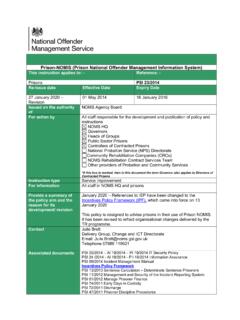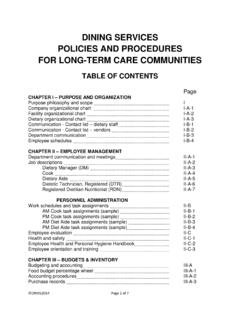Transcription of Workplace Skills Planning - WWF
1 1 HRD Toolkit Module II: Workplace Skills Planning Module 2 A Guide to improved Workplace Skills Planning 2 HRD Toolkit Module II: Workplace Skills Planning Workplace Skills Plans Workplace Skills plans (WSP) document Skills needs in an organisation and describe the range of Skills development interventions that an organisation will use to address these needs. A WSP is developed annually for the period 01 April to 31 March - by a registered Skills development facilitator (SDF) and is submitted to the SETA with which the organisation is registered. The WSP facilitates access to the SETAs mandatory grant for Skills training. Organisations are required to report against their WSPs in an Annual Training Report (ATR) that shows how they have addressed the priority Skills defined in the WSP.
2 An equally important purpose of the WSP is that it also provides important sector information to the SETA on employee profiles, Skills needs and Skills development interventions. This information in turn informs the development of the SETAs sector Skills plan (SSP). The SSPs then further make a contribution to the national Skills development agenda defined in the National Skills Development Strategy, now in its 3rd generation. Though developed at an organisation level to address in house Skills development needs, the WSP has an important purpose in informing Skills needs at a sector level and at a national level. In response to a need identified by human resource development practitioners in the environment and conservation sectors, this module has been written to support organisations in strengthening the processes through which they develop WSPs.
3 The ultimate aim being to support Skills development at a sector and national level. We start this module with an overview of some of the challenges that organisations and professionals experience in the process of developing WSPs. This section opens up for us the various aspects in human resource management and development that needs to be addressed to ensure more accurate and well informed WSPs. It further takes you through a range of considerations in preparing your organisation for work place Skills Planning . And then deals with some key processes to strengthen Workplace Skills Planning in your organisation. Some of the considerations and processes dealt with include, amongst others registering a SDF, setting up a training committee, engaging stakeholders in identifying and addressing Skills needs, Skills audits and ultimately preparing and submitting the WSP.
4 3 HRD Toolkit Module II: Workplace Skills Planning Challenges in Workplace Skills Planning Many human resource management and development professionals agree on a number of challenges experienced during Workplace Skills Planning . Some of these challenges occur at an organisational level and others at the sector Skills Planning level in the SETAs. Our human resource management and development practitioners however agree that, since the WSP feeds into the SSP we could potentially address the Skills Planning issues at a sector and SETA level if we start at the organisational level. Reflect on this list as a way of identifying and unblocking the constraints to Workplace Skills Planning in your own organisation. These are some and probably not all - of the challenges at an organisational level.
5 These are perhaps easier to address through change in internal systems, orientations and engagements. This module makes some suggestions for Workplace Skills Planning to help you overcome and address these challenges. Poor information management from which data is extrapolated for Skills Planning , for example employee qualifications, experience profile etc. and WSPs of former years are seldom used as baseline data to build up this information system. Poorly defined job descriptions which are seldom aligned to organisational strategy and strategic priorities. Skills needs often focus on immediate need with little consideration for change, organisational development and future anticipated Skills needs. Skills development and training is sometimes not viewed as a strategic priority and at times lacks executive and broader management buy-in and support.
6 The significance value and importance of Skills Planning and development is sometimes not fully understood in organisations and results in Skills Planning and development processes not enjoying full line management and employee support, representivity and engagement. Many WSPs reflect generic Workplace -based Skills needs, like computer training, financial management, report writing, amongst others, and critical and scarce Skills related to key technical and functional areas in the organisation are seldom identified and addressed. Workplace Skills Planning is seldom aligned to the performance management and other human resources management systems, procedures and practices. Workplace Skills Planning is often approached from a compliance perspective and very often outsourced to consultants and not institutionalised in the organisation to strengthen this level of in-house capacity.
7 Training and Skills development is more often than not menu-driven and priorities identified relative course offerings marketed by training providers. Few organisations have Skills Planning and development quality management systems and might result in poorer quality approaches to defining and addressing Skills needs. 4 HRD Toolkit Module II: Workplace Skills Planning Trish Persad from South African Weather Services, with experience in working with SETAs advises to register an SDF as soon as possible and to use the SETA training systems to ensure the development of capacity for the SDF to lead Skills development in your organisation. Preparing the Workplace for learning Our colleagues who have trudged through developing a number of annual Workplace Skills plans over the years advise us to prepare the internal environment well for Skills Planning and development.
8 This preparation would involve setting up the necessary structures, identifying and ensuring the appropriate capacity to lead the process of Workplace Skills Planning , securing support and participation from the executive committee, line management and the broader staff complement and securing the necessary resources both financial and human to facilitate the timeous development and submissions of the WSP. Registering a Skills Development Facilitator (SDF) All SETAs require the nomination and registration of a Skills Development Facilitator (SDF) who acts as the link between the organisation and the SETA of registration around all matters relating to Skills Planning and development. Most SETAs have an online system for registration of the organisations SDF. The SDF could be an employee of the organisation or an external consultant, who represents more than one employer organisation.
9 The SDF is responsible for providing strategic guidance, support and management to the organisation in developing and implementing a Skills Planning and development strategy. Key responsibilities of the SDF include: Facilitating the process of identifying key organisational Skills needs to meet its mandate; Undertaking a Skills audit in relation to these identified organisational needs to identify immediate, medium term and long term Skills gaps in the organisation; Defining a range of Skills development strategies to address Skills needs in the immediate, medium and long term. From this pertinent information develop an annual WSP, ensure its endorsement in the organisation and submit this timeously to the SETA of registration. Oversee support and quality assure the implementation of Skills development interventions to meet the immediate Skills development needs as defined in the ESP.
10 Monitor and evaluate skill development in the organisation relative to these needs and report in to the SETA through the annual training report Liaise with SETA around access to discretionary grant and facilitate the development and submission of appropriate proposals to access this grant. 5 HRD Toolkit Module II: Workplace Skills Planning From this description of responsibilities it is evident that the SDF needs to be someone with a knowledge, background and experience in Skills development and training. It would also be useful for the person to have an extensive knowledge of the Skills development policies and systems in South Africa. The ETDP SETA offers training for individuals to become accredited SDFs. They use 6 unit standards for identifying competence as an accredited SDF. These 6 unit standards provide a useful framework around which to profile the job definition of the SDF in your organisation and help you to identify the appropriate person to fulfil these responsibilities.









